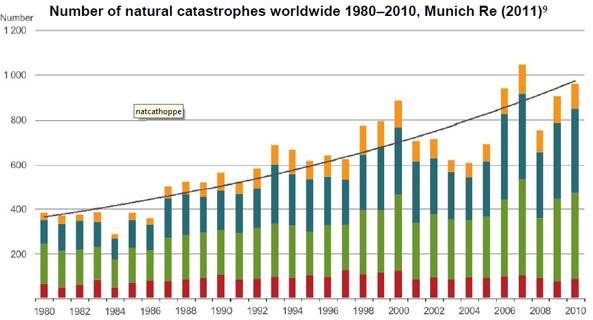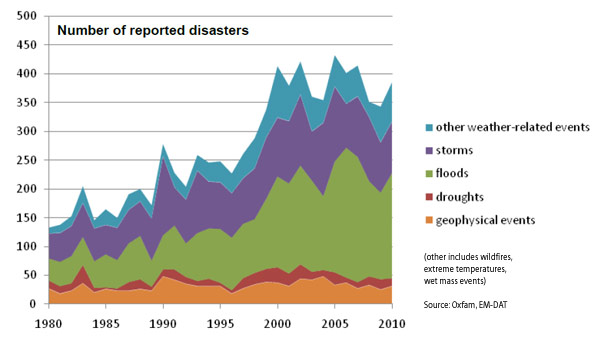updated 05/2017
It’s midweek and I am meeting some people.
“…. what do you do?” The question is innocent enough at any social gathering. What happens next however is always quite interesting for me. When I say “I am in Emergency and Disaster Preparedness, we create Preparedness Kits for individuals, business, organizations and local government” I either get a blank stare and the topic moves swiftly on or it gets engaging:
What do you mean by Preparedness? What Disaster? Where?
Now, that is a very good question. There is a quite a bit of confusion and a considerable gap between theory and practice – that is the difference between disaster theory and actual disaster risk reduction (DRR) and, more recently, preparedness. Thankfully, clarity has improved and the gap is closing for Disaster Preparedness concerns us all – and not just philosophically:
“Live moves very fast. It rushes from Heaven to Hell in a matter of seconds” — Paul Coelho

As imagery of that quote I particularly like the 12th century ‘Ladder of Divine Ascent’ at Saint Catherine’s Monastery in Sinai which, to me, is a good visual analogy of the precariousness of life as we strive for (ultimate) peace and security.
Predicting the future is no easy task, even with today’s amazing tech and science to help us understand and manage the risks associated with globalisation, urbanisation, climate change, population growth, dwindling resources, etc.
New technologies combine with existing ones, changing old and well understood hazards, and creating new ones in the process. People and communities worldwide – including the UK – become more vulnerable as a result of these new hazards in ways that we may not have encountered before – ways even that are hard to imagine.
What will be the ‘next Ebola’? Whatever it is – we’re not ready for it. https://t.co/SyPTI9Q4eK pic.twitter.com/cmRgvSEoOp
— Nature News&Comment (@NatureNews) August 8, 2015
‘Natural’ disaster data – perhaps not as straightforward as you may think…
 So called ‘natural disaster’ data is readily available nowadays but the term is actually a bit of an oxymoron. Natural events trigger a range of ‘disasters’, the resulting damage is largely the result of lack of planning and poor development which ends up putting property and people at risk.
So called ‘natural disaster’ data is readily available nowadays but the term is actually a bit of an oxymoron. Natural events trigger a range of ‘disasters’, the resulting damage is largely the result of lack of planning and poor development which ends up putting property and people at risk.
I said it before. I will say it again & again &again. Let’s get rid of the social construct of ‘natural disasters’ together! #MEXICOGP2017 pic.twitter.com/abCjKFUtZa — Ksenia (@KsChmutina) May 25, 2017
Another issue is that most disaster data, like the following graphs, are biased. The one by the insurer MunichRe is skewed towards the developed world, as opposed to, for example the EM-DAT based Oxfam report Time’s Bitter Flood which focuses on developing countries. There are other subtleties that may get ‘lost’ in how data is entered into international databases such as the one by the Centre for Research on the Epidemiology of Disasters CRED. Often not being considered (but thankfully that is also changing) are issues of geographical or time scale (no difference between 10 deaths in 1 min or 6 months) or that gross rather than normalized data is emphasized, yet there can be significant differences between total damage and per capita damage. Despite these limitations the various data nevertheless show a clear trend:
A clear trend: Natural Disasters / Catastrophes are increasing

 And now, another ‘bad’ El Nino seems a certainty:
And now, another ‘bad’ El Nino seems a certainty:
This year El Niño is back. And it’s going to be a bad one https://t.co/S6cGRgux5N pic.twitter.com/QLS61bkziC #elnino — New Scientist (@newscientist) May 13, 2015
Impacts from disasters are complex and wide-reaching but more importantly, they affect us all in a myriad of direct and indirect ways even on the ‘other’ side of the world. Disasters do not respect boundaries, whether geographical, social, economic or political5. For a historic insight into disasters located in the UK, Wiki has a couple of interesting lists: List of disasters in Great Britain and Ireland by death toll and List of natural disasters in Great Britain and Ireland .
So, what then is a disaster?
Actually, that’s another excellent question for the term has been used in many different ways1. Operational definitions are important since they trigger political decisions and a flow of resources.
Disasters are more than ‘just’ large emergencies and catastrophes are more than ‘just’ large disasters.
How we talk about and define ‘disaster’ has implications for what kind of research is undertaken and what strategies and resources are used to manage them. Disaster is an intellectually complex and emotionally loaded word that should be used with care. Theory is important as it underpins good practise. For example, in creating hazard maps, different concepts of ‘disaster’ need to be considered not just rapid onset well-defined events like an earthquake or a volcanic eruption but also slow onset diffuse events like droughts which only recently are being considered as disaster events1 (also see the current California Mega Drought or Wiki Historic Examples of Drought directly affecting India, Russia, China, USA, Australia and many countries in Africa but having much wider impacts).
‘Dis-aster’ (Latin) literally means ill-favoured star
 Jupiter, the king of the gods and the god of sky and thunder
Jupiter, the king of the gods and the god of sky and thunder
That is one way of revealing its origins in a classical and fatalistic worldview that saw calamities as coming from the heavens (or as in my later example above the daemonic nether regions).
Most traditional interpretations tend to revolve around agent descriptions, physical damage, social disruption and negative evaluation while more modern approaches favour social constructionism and the disruptions during and after a natural disaster event2.
A disaster is more than one thing (object, event, feeling) to different people and so while theorists may argue for a single, concise definition there is value in diversity.
What ‘disaster’ means to people is subjective, first and foremost and thus not so easily definable. People across the world interpret disasters differently, depending on their goals, cultural views and values.
Defining ‘disaster’ is complex and challenging
Disaster taxonomies exist similar to the ones used in biology3 and one commonly used typology is based on frequency, duration, area, onset speed, spatial dispersion and time spacing4. Other, rather coarse and overly simplistic categorizations use the labels ‘natural’ versus ‘technological/man-made’ or ‘rapid’ versus ‘slow onset’ as mentioned earlier.
Getting to grips with better taxonomies is important for both research and operations. Emergencies, disasters and catastrophes all show different characteristics both quantitative and qualitative which necessitate different management and planning strategies. Now, all this, while interesting, is also quite ‘academic’.
Preparedness, on the other hand, is intensely practical. Even in research…
Preparedness refers to concrete sets of actions taken as precautionary measures in the face of potential disasters
This includes information and training as well as the physical preparations of adapting infrastructure and readying emergency supplies. In our current climate of dwindling public services and resources, business and individuals increasingly have to take on their own Emergency and Disaster Preparedness responsibilities. Naturally, this varies widely depending on the particular circumstances. However the necessity and utility of a good dose of self-sufficiency is, in my view, self-evident.
Being stronger and better prepared individually not only helps you to survive and bounce back, but automatically makes for stronger and better prepared communities.
Preparedness is empowering.
Preparedness is a diverse, practical toolkit that can make a huge difference. Start with our FREE resources. As an individual begin by making your own Emergency Plan. As a Business, especially if you are an SME, look into Business Preparedness and practical Business Continuity. And if you can’t find the practical resources and kit you want then give us a shout. Our specialty is, after all, custom-made kits and we’re always happy to help.
Until next time – I wish you lots of motivation to tackle your own Emergency and Disaster Preparedness and bring it into your wider communities.
Monika
Tweet Thank you for sharing, raising awareness for Emergency and Disaster Preparedness
References / Resources
- 1 Etkin, D. (2015) Disaster Theory – An Interdisciplinary Approach to Concepts and Causes. Butterworth-Heinemann (Elsevier) Oxford, UK
- 2Quarantelli, E.L (1998) What is a disaster? New Answers to Old Questions, ed. Perry and Quarantelli (USA, Xlibrib Corp) / (2000) Emergencies, Disasters and Catastrophes are different phenomena. University of Delaware DRC Preliminary Paper#304,6) / (2005) A Social Science Research Agenda for the Disasters of the 21st Century in What is a disaster? New Answers to Old Questions, ed. Perry and Quarantelli (USA, Xlibrib Corp)
- 3 Krebs, G.A. (1989) Description, Taxonomy and Explanation in Diaster Research. International Journal of Mass Emergencies and Disasters 7, no 3; p277-280
- 4 Burton et al. (1993) The Environment as Hazard. Guilford Press
- 5 Hannigan, J (2012) Disasters without borders. Polity Press. Cambridge, UK
For more EVAQ8 blog simply use the right hand navigation. For emergency kits and practical resources use the top navigation. For FREE resources head over to our Preparedness Hub and find out why we use humour. If you like this post, please share it to help raise awareness for Emergency and Disaster Preparedness. Thank you!
Find EVAQ8 on social media, like and follow us!



 This week, she reports that the LA County Office of Emergency Management launches a campaign asking faith-based community organizations to host disaster-preparedness events. US Churches, synagogues and mosques may soon help residents to prepare for what they call ‘the big one’ – an earthquake, tsunami or other major incidents.
This week, she reports that the LA County Office of Emergency Management launches a campaign asking faith-based community organizations to host disaster-preparedness events. US Churches, synagogues and mosques may soon help residents to prepare for what they call ‘the big one’ – an earthquake, tsunami or other major incidents.


